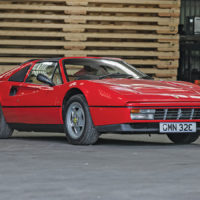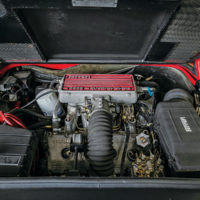SCM Analysis
Detailing
| Vehicle: | 1989 Ferrari 328 GTS |
| Years Produced: | 1986–89 |
| Number Produced: | 7,413 (GTB and GTS variants) |
| SCM Valuation: | $84,500 |
| Tune Up Cost: | $3,500 |
| Chassis Number Location: | Top right frame rail in the engine compartment |
| Engine Number Location: | Stamped on the top of the block near the oil filter |
| Club Info: | Ferrari Club of America |
| Website: | http://www.ferrariclubofamerica.org |
| Alternatives: | 1989–93 Lotus Turbo Esprit SE, 1981–88 Lamborghini Jalpa, 1990–94 Porsche 911 Carrera 2 Targa |
| Investment Grade: | B |
This car, Lot 717, sold for $108,814 (£86,625), at Silverstone Auctions’ Northampton, U.K., sale on June 4, 2022.
This could have been a record-breaking sale: A final-year 1989 example delivered through Nigel Mansell’s Ferrari dealership. A miniscule 2,760 miles from new. Resale red with beige leather and red carpets. A right-hand-drive car in a right-hand-drive market. However, it was not to be. What happened?
Rise of the V8
The 328 is the culmination of a series that started in 1973 with the 308 GT4, Ferrari’s first entry in its line of mid-engine V8 sports cars. This series would change the future of Ferrari.
The GT4 was intended to be a 2+2 addition to the Dino 246 series; however, it soon became a stand-alone model. Originally badged and marketed as a Dino, the 308 GT4 was quickly rebadged and sold as a Ferrari.
The 3.0-liter V8 that powered the GT4 was designed and built by Ferrari. The body was designed by Bertone, built by Scaglietti and assembled at Ferrari. The car was well engineered and well built, not fragile or finicky. Over 30 years later, the biggest complaints are a weak second-gear synchro and occasional spark-plug fouling.
Clients who balked at the GT4’s styling and 2+2 configuration were placated two years later with the introduction of the 308 GTB. The GTB shared the underpinnings of the GT4 but was configured as a two-place coupe and dressed in a beautiful Pininfarina-designed body. The 308 GTB will go down as one of the most attractive cars ever produced.
A Targa-top 308 GTS was added in 1978. Escalating emissions standards required the Weber carburetors to be replaced by Bosch fuel injection for 1980. Additionally, a new Bosch electronic ignition system eliminated any spark-plug fouling issues. A small “i” suffix was added to the car’s name to indicate the new injected version.
The fuel injection created a cleaner-burning engine but also sapped horsepower. Ferrari advertised the 308 GTBi and GTSi models as having the same output as the carbureted cars. Dyno testing revealed the claim was optimistic.
In 1983, Ferrari introduced an updated version of the 308 with four valves per cylinder. That effectively raised the horsepower to slightly above the original carbureted versions. The new model was designated the 308 GTB and GTS Quattrovalvole, and the “i” suffix was discontinued.
The last of a breed
For the 1986 model year, the 328 GTB and GTS arrived. Ferrari describes the model as “essentially a revised and updated 308.” The 328 naming convention indicates the model’s engine is a 3.2-liter variation of Ferrari’s V8. The additional displacement gave the engine a welcome bump in both horsepower and torque.
The 328 also featured new, better-integrated front and rear bumpers in body color. Ferrari describes the modification as a “softening” of the 308’s ’70s-era wedge design. New wheels and flush-mounted door handles were also part of the update.
During the latter part of 1988 328 production, Ferrari made further updates. Anti-dive suspension borrowed from the Mondial 3.2 was introduced, along with convex wheels that would soon be needed to accommodate anti-lock brakes that were due a few months later. Known as the “88.5” model, this is the ultimate 328 and the one that I recommend.
The final year came in 1989, when the 328 featured the 88.5 updates, plus ABS. While collectors covet the car for being a last-year example, ABS parts are scarce, which is why I prefer the penultimate version.
A celebratory sale
Silverstone’s auction was titled “A Sale of Ferraris,” held on National Ferrari Owner’s Day, a celebration put on by the Ferrari Owners’ Club of Great Britain. The event was held at the Sywell Aerodrome, a vintage-airplane museum and airfield. The 2021 event drew 600 Ferraris in attendance. This year celebrated the 75th anniversary of the marque and a larger crowd was expected.
Silverstone offered 22 Ferraris at auction. The selection ranged from a couple of 1973 Dino 246s to a 2017 F12. An impressive 17 of the 22 inventoried Ferraris were sold. (See Market Report, p. 124.)
Low miles, questionable condition
The SCM Platinum Auction Database shows six 328 GTS sales above $150,000 since mid-2020. On the surface, this car should have sold in that area. It is a final-year example with just 2,760 miles indicated. It is the most popular red/tan combination, attractively contrasted with red carpets. The Nigel Mansell Ferrari dealer history adds a nice story. What’s not to like?
Silverstone notes the car is in “generally good” condition, an underwhelming description for a 2,700-mile car. They also note it needs “mechanical recommissioning” due to years of dry storage. The recommissioning would entail refreshing all the fluids, replacing some filters, and replacing the timing and drive belts. The tires will also need replacing. Add a couple of grand for the unexpected and the cost would come in around $6,000, not that much more than a routine major service.
Right-hand drive is a bit of a wild card; desirable in an RHD market, but not desirable on the larger global market. (Spotter’s tip: Four consecutive zeros in the serial number indicate a Ferrari is a non-U.S. model. U.S. cars never have more than two zeros in a row.)
The price paid, nearly $109,000, is a lot of money for an average 328 GTS. Still, anyone following online auctions knows ultra-low-mileage unicorn Ferraris are hot. They can bring 50% to 100% more than average-mileage cars. That is what I expected from this sale until I examined Silverstone’s pictures. A picture of the driver’s seat showed extensive wear to the outside bolster. The wear was indicative of high mileage or excessive usage. Short of selling pictures of people sitting in a Ferrari, I cannot imagine how the seat got that worn.
This is an example of a car that does not live up to its story. Unless there’s other damage, whoever bought this car should recommission and refurbish it. Once brought up to a condition that matches expectation, the buyer should be able to turn a nice profit. ♦
(Introductory description courtesy of Silverstone Auctions.)


